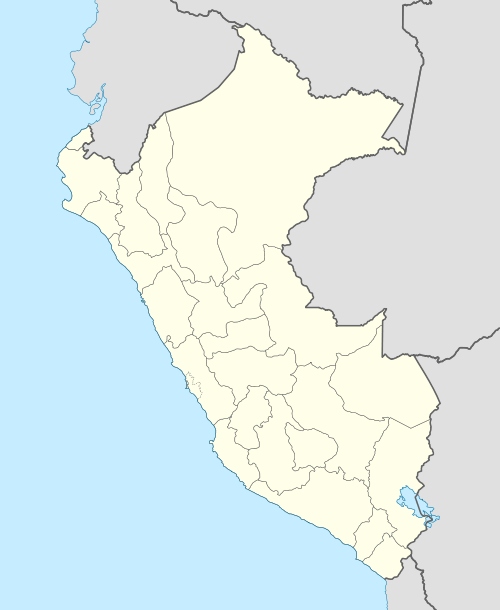Talara
| Talara, Peru | |
|---|---|
| City | |
|
An oil pump in Talara | |
 Talara, Peru | |
| Coordinates: 4°34′47.65″S 81°16′18.76″W / 4.5799028°S 81.2718778°WCoordinates: 4°34′47.65″S 81°16′18.76″W / 4.5799028°S 81.2718778°W | |
| Country | Peru |
| Region | Piura |
| Province | Talara |
| Government | |
| • Type | Democracy |
| • Mayor | José Alfredo Vitonera Infante |
| Elevation | 11 m (36 ft) |
| Population | |
| • Estimate (2015)[1] | 90,830 |
| Time zone | PET (UTC-5) |
| • Summer (DST) | PET (UTC-5) |
| Website |
www |
Talara is a city in the Talara Province of the Piura Region, in northwestern Peru. It is a port city on the Pacific Ocean with a population of 103,200 as of 2005. Its climate is hot and dry. Due to its oil reserves, and ability to produce aviation fuel, Talara hosted a United States air base during World War II. Talara is also home to a large fishing fleet. The city is served by the Cap. FAP Víctor Montes Arias Airport.
One of the attractions of Talara is its gastronomy, you can find good seafood restaurants. There are many of them at Caleta's San Pablo, a district of Talara.
Talara is the westernmost city in all of mainland South America. (A small outlying town, Seccion Dieciocho, is situated slightly further west, and just beyond there, the land itself reaches its westernmost extent at Punta Pariñas.) Talara and some neighbouring cities (Piura and Amotape) served as the backdrop for the short novel 'Who Killed Palomino Molero?' by Mario Vargas Llosa.
Climate
| Climate data for Talara | |||||||||||||
|---|---|---|---|---|---|---|---|---|---|---|---|---|---|
| Month | Jan | Feb | Mar | Apr | May | Jun | Jul | Aug | Sep | Oct | Nov | Dec | Year |
| Average high °C (°F) | 30.0 (86) |
30.7 (87.3) |
30.8 (87.4) |
30.2 (86.4) |
28.2 (82.8) |
26.2 (79.2) |
24.7 (76.5) |
24.2 (75.6) |
24.2 (75.6) |
24.5 (76.1) |
25.7 (78.3) |
27.7 (81.9) |
27.3 (81.1) |
| Average low °C (°F) | 19.7 (67.5) |
20.8 (69.4) |
21.2 (70.2) |
20.3 (68.5) |
18.7 (65.7) |
17.1 (62.8) |
16.1 (61) |
15.6 (60.1) |
15.5 (59.9) |
15.7 (60.3) |
16.4 (61.5) |
17.7 (63.9) |
17.9 (64.2) |
| Average rainfall mm (inches) | 1.7 (0.067) |
1.1 (0.043) |
6.7 (0.264) |
0.7 (0.028) |
0.0 (0) |
0.1 (0.004) |
0.0 (0) |
0.0 (0) |
0.0 (0) |
0.4 (0.016) |
0.1 (0.004) |
0.1 (0.004) |
10.9 (0.429) |
| Source: Senamhi[2] | |||||||||||||
See also
References
- ↑ Perú: Población estimada al 30 de junio y tasa de crecimiento de las ciudades capitales, por departamento, 2011 y 2015. Perú: Estimaciones y proyecciones de población total por sexo de las principales ciudades, 2012-2015 (Report). Instituto Nacional de Estadística e Informática. March 2012. Retrieved 4 June 2015.
- ↑ "Promedio de temperaturas y lluvias para todo el año–Talara" (in Spanish). Servicio Nacional de Meteorología e Hidrología del Perú. Retrieved 22 December 2015.